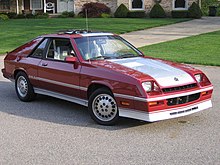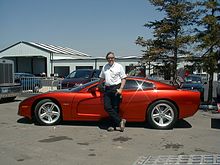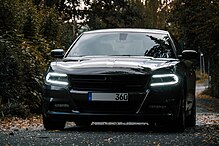Dodge Charger
| Dodge Charger | |
|---|---|
| Production period: | 1966–1978 1981–1987 since 2005 |
| Class : | Sports car |
| Body versions : | Coupé , sedan |
Dodge Charger is the name of several car models from the US car manufacturer Dodge . The first models belonged to the muscle car division and are still among the most popular classic US vehicle models. In the 1980s, Charger was the name of the coupe version of the Dodge Omni . The current Charger model is a four-door sedan .
history
In 1964, Dodge presented the study of a sporty coupé , which, in keeping with the fashion of the time, with a hatchback ("fastback") and large radiator grille was intended to appeal to young customers in particular. In 1965 a small series of the Dodge Dart with a more powerful 4.5 l engine was presented under the name “Charger 273”, and in 1966 the series model came onto the market. The design largely corresponded to that of the study, the engines offered were exclusively the V8 machines popular in the USA .
Muscle Cars: 1968 to 1974
Since those in charge at Dodge were of the opinion that the first charger looked too clumsy and old-fashioned, a completely new model came on the market as early as 1968. It looked even sleeker than its predecessor and was built with this body up to and including 1970. These three model years were the most successful, and the sales figures of that time could not be achieved later. The R / T ("Road / Track") models with the Hemi V8 engine in particular were considered to be the sure winners of every acceleration race, even though the Chrysler concern with the Charger and the similar Plymouth Road Runner models in NASCAR Until 1970, he was always second behind the Ford vehicles.
In 1971 the Charger was given a new body shape, which was built with only minor changes until 1974.
Personal Luxury Cars: 1975 to 1978
Since the mid-1970s, ever stricter emissions laws came into force in the USA, and buyers increasingly preferred comfort-oriented models instead of muscle cars . From 1975 Dodge took this development into account with a redesign of the Charger, which led to a departure from the previous model policy and at times caused irritation. In the 1976 model year, for example, Dodge offered two different cars under the model name Charger, both of which were positioned in the Personal Luxury Cars segment .
Charger S / E
The Dodge Charger S / E presented in 1975 was a comfort-oriented touring car that was only offered as a two-door coupé. It was a stylistically and technically almost unchanged version of the Chrysler Cordoba . Like the Cordoba, the Charger S / E was based on the Chrysler B platform ; overall, they were closely related to the two-door version of the Dodge Coronet . The only difference between the Charger S / E and the Chrysler Cordoba was a modified radiator grille and separate rear lights. Eight-cylinder engines with a displacement of 5.2 to 6.6 liters served as the engine.
The Dodge Charger S / E sold significantly worse than the identical Chrysler Cordoba. While more than 700,000 copies of the Cordoba were produced from 1975 to 1979, only 142,000 vehicles were built of the Charger S / E. At the beginning of the 1978 model year, Dodge took the Charger S / E off the market. It was replaced by the Dodge Magnum , which in turn was based on the Charger S / E, but had its own front section with pop-up headlights and was given a sportier look.
Charger coupe
In parallel to the Charger S / E, Dodge offered the Charger Coupé in model year 1976. This model was the result of a marketing decision to reorganize the model names at Dodge. The Charger Coupé was a two-door notchback coupé that had been sold under the model name Dodge Coronet the year before. Outwardly, the Charger Coupé had no resemblance to the Charger S / E and was instead identical to last year's Coronet. Unlike the Charger S / E, this car was offered as standard with a 3.7-liter in-line six-cylinder engine ("Slant Six"), but could also be equipped with larger eight-cylinder engines as an option. Almost 24,000 copies of the Charger Coupé were produced in 1976.
The car was marketed as the Charger Coupe only in 1976. From the model year 1977, when the Coronet was given the model name Monaco , the (again unchanged) car was part of the program as the Monaco Hardtop Coupé. This gave it its third model name after Coronet and Charger.
Compact car: Omni 1983 to 1987
The Dodge Charger from 1983 to 1987 was a sports coupé based on the Dodge Omni (with Volkswagen and Peugeot engines, among others ), but there was no longer any connection with the original models.
Study (1999)
At the Detroit Motor Show showed DaimlerChrysler 1999, a sports car study with the name "Dodge Charger R / T". Not only the name should be reminiscent of the successful models of the 1960s, the design of the rear section was based on the shape of the Charger models from 1968 to 1970. It was a streamlined sports car that had associations with the Dodge Viper . The radiator grille carried the Dodge cross of the current models, the sideline again had the " Cokebottle " shape that was popular at the time . The vehicle was powered by a 4.7-liter V8. The only unusual features of a modern muscle car were the use of natural gas as fuel and the move towards a body shape with four doors. After a few presentations for the press, which also included test drives, the study disappeared from the scene again. The "Dodge Charger R / T" was never developed into a production model.
LX sedan (since 2005)
In 2004, the pre-series production of a new charger for the 2006 model year, a sedan, began. This version also has a powerful R / T version, which is driven by a Hemi-V8 as before and advertised with the successes of the classic Charger models.
| model | 2.7 V6 | 3.5 V6 | 5.7 V8 | 6.1 V8 |
|---|---|---|---|---|
| Number of cylinders | 6th | 6th | 8th | 8th |
| Displacement (cm³) | 2736 | 3518 | 5654 | 6063 |
| Max. Power (kW / DIN-PS) | 150/203 | 184/253 | 250/354 | 317/431 |
| Max. Torque (Nm) | about 250 | 340 | 525 | 569 |
| Top speed (km / h) | 210 | 220 | 250 | 265 |
| Acceleration (0-100 km / h) | s | s | 6.0 s | 5.3 s |
| Combined consumption (l / 100 km) | 11.0 | 11.4 | 12.4 (13.0 AWD) | 14.0 |
LD Limousine Facelift (since 2011)
| model | SE / SXT | R / T | SRT8 |
|---|---|---|---|
| Number of cylinders (V-engine) | 6th | 8th | 8th |
| Displacement (cm³) | 3604 | 5654 | 6424 |
| Max. Power (kW / PS) | 218/296 | 271/370 | 351/477 at 6000 |
| Max. Torque (Nm) | 353 at 4800 | 535 at 4200 | 637 at 4300 |
| Top speed (km / h) | 220 | 250 | > 280 |
| Transmission (standard) | 5 or 8 level automatic | 5 level automatic | 5 level automatic |
| Acceleration (0-100 km / h) | 6.4 s | 5.19 s | 4.3 s |
| Test consumption combined (l / 100 km) | 11.3 | - (- AWD) | 16.1 great |
LD Limousine Facelift (since 2015)
| model | SE / SXT | R / T | SRT392 / R / T Scat Pack | Dodge Charger SRT Hellcat |
|---|---|---|---|---|
| Number of cylinders (V-engine) | 6th | 8th | 8th | 8th |
| Displacement (cm³) | 3604 | 5654 | 6424 | 6166 |
| Max. Power (kW / PS) | 218/296 | 271/370 | 362/492 | 527/717 |
| Max. Torque (Nm) | 353 at 4800 rpm | 535 at 4200 rpm | 644 at 4300 rpm | 881 at 4800 rpm |
| Top speed (km / h) | 220 | 250 | 282 | 315 |
| Transmission (standard) | 8 level automatic | 8 level automatic | 8 level automatic | 8 level automatic |
| Acceleration (0-100 km / h) | 6.4 s | 4.9 s | 4.2 s | 3.7 s |
| Test consumption combined (l / 100 km) | 11.3 | 12.4 (- AWD) | 16.1 great | 15.4 great |
Source:
Current version
With the current model, Dodge gave the Charger another facelift in 2015. The most noticeable changes are the new grill, the front bumper with round LED headlights and the appropriately adapted rear. The 1969 model served as inspiration for this design.
The current charger is offered with a 3.6l V6 (SE / SXT), a 5.7l V8 (R / T), a 6.4l V8 (SRT) engine. Dodge has also been building the new Charger SRT Hellcat with a 6.2l V8 since 2015 , which, thanks to the supercharger, produces 717 hp. This engine is also installed in the Dodge Challenger SRT Hellcat .
Dodge produces the Charger in two versions as a police vehicle: as a Pentastar V6 with 3.6 liter displacement and an output of 296 hp and as a 5.7 liter HEMI V8 with 375 hp. The vehicles are equipped with rear-wheel drive as standard, but can also be equipped with all-wheel drive. The California Highway Patrol has been introducing the Charger as an emergency vehicle into its fleet since 2017 .
Brazilian version
From November 1970 on, Chrysler Brazil built its own high-performance variants based on the local Dodge Dart Coupé under the name Charger LS and Charger R / T. Both models were powered by the sedan's 5.2-liter V8 (318 cui), but instead of 201 it produced 208 SAE PS (in the LS) and, with double exhaust, 218 PS (in the R / T). The LS had a three-speed, the R / T a four-speed manual transmission. In 1973 the Charger got double headlights and modified rear lights. In 1976 the Charger LS was discontinued, in 1977 the compression of the Charger engine was reduced (whereby the output sank to 211 SAE-PS), and from 1978 on the bonnet dummies were dispensed with. In 1979 the Charger R / T received an extensive facelift with a new front section, a plastic nose and blinds on the rear side windows; the chassis was also designed to be softer. In 1980 the production of the Charger R / T was stopped.
Web links
Individual evidence
- ^ Langworth: Encyclopedia of American Cars 1930-1980, pp. 269, 286.
- ↑ Illustration of both Chager versions in the sales brochure from 1976.
- ↑ Pictures of the Charger R / T concept vehicle at the Detroit Motor Show 1999, Pictures_1 , Pictures_2 , Photos_3
-
↑ DriveSRT.com:
- (no longer available!) Brochure (2013) about all Dodge SRT models ( page no longer available , search in web archives ) Info: The link was automatically marked as defective. Please check the link according to the instructions and then remove this notice. including Charger SRT, accessed on July 7, 2014
- Charger 2014 brochure , accessed Sept. 2, 2015
- Charger 2015 - "Online Brochure" , accessed Sept. 2, 2015
- ↑ Dodge Charger Pursuit 2015: New Police Car for the USA |. Retrieved June 2, 2020 .
- ↑ CHP is switching from SUV-style patrol cars to sleek Chargers. In: Orange County Register. March 21, 2017, accessed June 2, 2020 (American English).
- ↑ All information according to: http://www2.uol.com.br/bestcars/cpassado/dodge-1.htm








